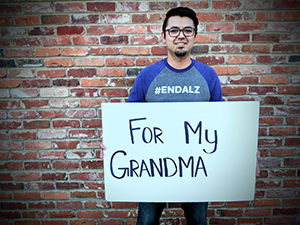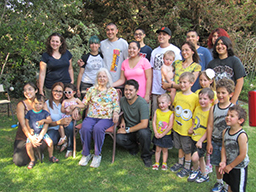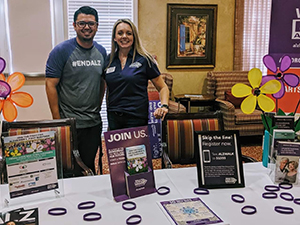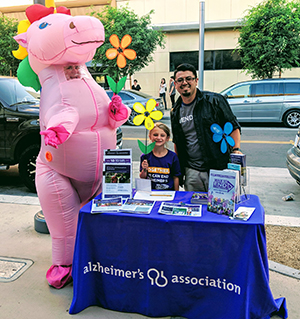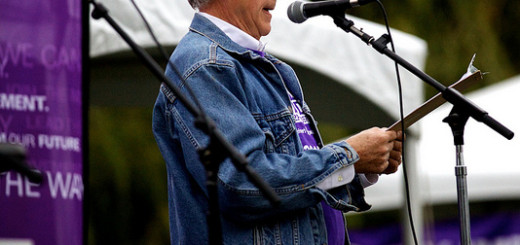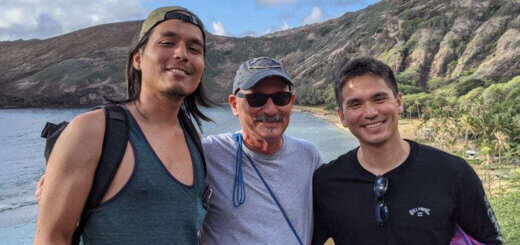Fresno Walker helps caregivers improve time spent with loved ones
Quincy Ariz’s grandmother Ruby had Alzheimer’s disease. Taking what he learned as a professional in the senior care industry, Quincy was able to meaningfully connect with his grandmother one last time before she died. Quincy uses his role on the Walk to End Alzheimer’s® Planning Committee to ensure that other families get the help they need to make the most of the time they have left with their loved ones.
Sleepovers at Grandma’s
Quincy’s grandmother, Ruby Jamie, was the kind of woman who would invite all of her grandchildren to her home for a slumber party. With all the kids piled in the living room, she made sure she had a pot of beans on the stove and candy in the candy dish.
When Quincy was around 10 years old, Ruby was diagnosed with Alzheimer’s disease. Because of this, Ruby stopped inviting her grandchildren over to spend the night.
Quincy, who had a picture-perfect memory of the exact layout and detail of his grandmother’s home, quickly noticed when things began to disappear. “Furniture was missing,” said Quincy. “Art and pictures the grandkids had given to her were no longer on display. The candy dish and the collection of salt and pepper shakers started to change and eventually disappeared.”
Now, as a senior care professional, Quincy can look back and recognize that many of the changes made were for Ruby’s safety, but as a child growing up, he felt like he was losing a part of himself.
Helping others
While working in a care setting wasn’t Quincy’s original plan, he fell into it naturally after graduating college. His experience with his grandmother made the work he did in the senior care industry that much more relevant.
It was also through his career that he learned how to meaningfully interact with people who were living with Alzheimer’s. “Working here gave me those tools,” said Quincy. “I can help people who are caring for someone who is currently going through this journey. I can help them connect with their mom or dad or their best friend. It’s very satisfying and comforting to me pay it forward.”
Tips for quality visits
For Quincy, a quality visit is when both the person living with the disease and the caregiver are actively engaged with each other. When the visit ends, both parties are in a better place than when they started. It should never feel like a chore.
“People just sit and look at each other,” said Quincy. “They talk amongst themselves and not with their loved one. Quality visits are more than just laying eyes on someone.”
Here are some tips Quincy suggests for a quality visit:
- Holding hands
- Rubbing their back
- Singing the songs they remember
- Bringing their favorite food
- Sharing something nostalgic that will bring them joy
“Engage with them,” said Quincy. “It’s a catalyst that will fuel the rest of the day.”
A quality visit with Ruby
Quincy was able to use the tools he learned on his own grandmother and had a bittersweet experience with her towards the end of her life.
“It was one of the last times Grandma was still Grandma,” shared Quincy. “She was up walking around, giving us hugs, talking to us and sharing a meal. I sat with Grandma, I felt mighty and powerful, knowing that I knew how to connect with her. I was feeling confident.
“We had a great and wonderful visit, holding each other’s hands, laughing, pointing and talking about other grandkids. We were in tune with each other and understood each other. We enjoyed each other and it felt great. It was exactly what I wanted to happen.”
Sadly, as Quincy walked away, he heard his grandmother say, that she was having such a good time, but she didn’t know who he was.
“That breaks someone emotionally,” shared Quincy. “It hurt me and saddened me, but it was nice to know that the moment we had just enjoyed and experienced was so positive and meaningful to her.
“Her mood was up for the rest of the day. She was happy and pleasant and that made me feel good. The lingering effects of that great visit carried through for everyone else that day.”
Ruby died in 2019.
Joining the committee
In 2010, Quincy learned about the Fresno-Madera Walk to End Alzheimer’s. He participated in Walk for several years until eventually, he decided he wanted to do more, and joined the Walk Planning Committee.
Committee members plan each Walk to End Alzheimer’s event from the kick-off to the wrap-up. Members break into the following subcommittees:
- Sponsorship
Recruit and manage relationships with new and past sponsors - Team Recruitment
Recruit new teams and helping them get set up for success - Team Retention
Manage relationships with past Walk teams - Marketing & Outreach
Create awareness of the disease and the Alzheimer’s Association® through the promotion of Walk to End Alzheimer’s - AIM-Advocacy
Recruit new Alzheimer’s Impact Movement (AIM) members and advocates from all sectors of the community - Mission
Organize activities that focus on the Association’s mission at committee meetings, wrap-around events and on Walk day - Logistics
Oversee day-of-event logistics and volunteers
Currently, Quincy helps with marketing and outreach. Being on the committee is an opportunity to use skills he doesn’t necessarily get to use at work every day. “Sometimes at work you’re stuck in a box on what you’re expected to do,” said Quincy. “You’re not able to nurture your other interests. The committee helped me do that. I was able to cross things off of my list.”
Feeling the impact
“I love being on the committee,” said Quincy. “Because although the Walk takes steps forward ever year towards the ultimate goal of finding a cure, being on the committee helps me realize and see how big those steps actually are. You can feel the progression forward.
“As a Walker and a fundraiser, you may ask yourself, what exactly did I do? What did I accomplish? Being a part of the committee, you can feel the impact you’re having. It’s great feeling that way.”
Providing support
Every day Quincy sees families struggle to figure out how to navigate a quality visit with a loved one who doesn’t remember them. There are family members and caregivers who have never heard of the Alzheimer’s Association or Walk to End Alzheimer’s.
“It’s heartbreaking to know that the majority of people we meet never knew about the Alzheimer’s Association support services until after their loved one has passed,” said Quincy. “It makes me wonder what kind of life they could have had, had they had the right support to facilitate a good visit, or handle a situation in different way.
“I know that funds raised by the Walk help provide education and support groups to those families. It helps fund the 24/7 Helpline (800.282.3900). If they have a question at 3 a.m. there is always someone there.”
As word of the Walk has spread Quincy says, “We’re getting support to families earlier so they’re spending quality time with their loved ones.”
Finding hope
When Quincy first began attending Walks, 11 years ago, he felt like the Walk was a memorial, a way to honor those who had died with dementia. Now he feels like Walk is more hopeful.
There are more people aware of the disease. More people empowered to help their loved one by using the services provided by the Alzheimer’s Association.
“The message, the heart and the purpose of the Walk has always remained the same,” said Quincy. “It’s about celebrating life and accomplishments. We’re so much closer to finding a cure and new treatments. If I can give anyone one more day of clarity, I will.
“I walk for the future and to protect my families’ memories. I want them to remember our trips to Disneyland, swimming in the pool or celebrating “˜summer Christmas.’ It’s really fun and cool to be part of something that is actively making a difference in our own communities. People are seeing the positive effects of how the Alzheimer’s Association is helping everyday people living meaningfully every day.”
You can join Quincy’s team, Sunrise – Red Hot Chili Steppers or form your own team and join us for the Fresno-Madera Walk to End Alzheimer’s on September 18 at the Tesoro Viejo Welcome Center in Madera. Not in Fresno or Madera? Find a walk near you at alz.org/walk.
To join the Walk Planning Committee in your local community search for the Walk to End Alzheimer’s nearest to you, click the ‘Volunteer’ button, and fill out the volunteer interest form.
Learn more:





